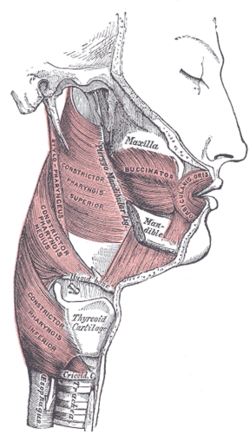| Pterygomandibular raphe | |
|---|---|
 | |
| Details | |
| Part of | Buccopharyngeal fascia |
| Origin | Pterygoid hamulus of the medial pterygoid plate |
| Insertion | Mylohyoid line of the mandible |
| Identifiers | |
| Latin | raphe pterygomandibularis |
| TA98 | A05.3.01.102 |
| TA2 | 2178 |
| FMA | 55618 |
| Anatomical terminology | |
The pterygomandibular raphe (pterygomandibular fold [1] or pterygomandibular ligament) is a thin [2] tendinous band of buccopharyngeal fascia. It is attached superiorly to the pterygoid hamulus of the medial pterygoid plate, and inferiorly to the posterior end of the mylohyoid line of the mandible. It gives attachment to the buccinator muscle (in front), and the superior pharyngeal constrictor muscle (behind).
